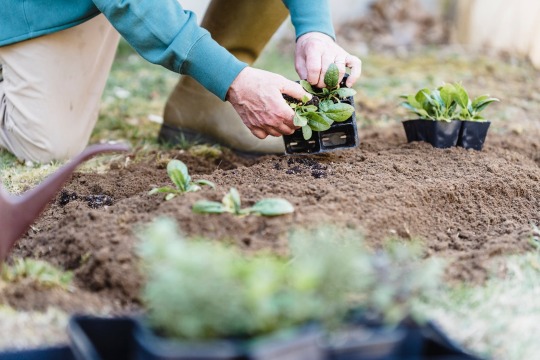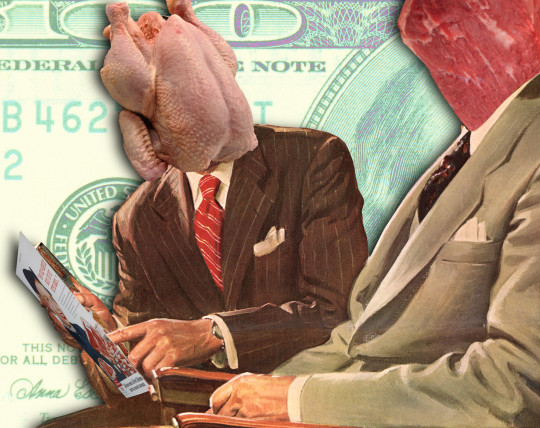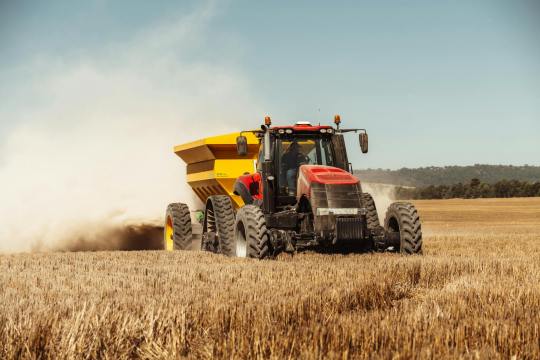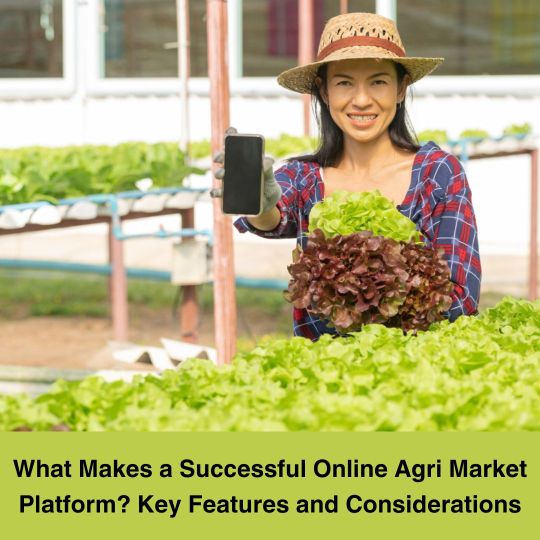#Agri-Markets
Explore tagged Tumblr posts
Text
Step-by-Step: The Comprehensive Process of Agriculture
Welcome to a detailed exploration of the fascinating world of agriculture! In this article, we will take you on a journey through the step-by-step process of agriculture, uncovering the intricate techniques and practices that cultivate the food we enjoy every day. From seed selection to harvest, each stage plays a crucial role in producing high-quality crops.
Welcome to a detailed exploration of the fascinating world of agriculture! In this article, we will take you on a journey through the step-by-step process of agriculture, uncovering the intricate techniques and practices that cultivate the food we enjoy every day. From seed selection to harvest, each stage plays a crucial role in producing high-quality crops. Importance of Agriculture in…

View On WordPress
#aagriculture#Advantages of Agriculture#AGRI#agri business ideas#agri startup ideas#Agri-Markets#Agri-Tech Startups#agri.#Agribusiness#Agribusiness Sector#Agribusinesses#agricultural#agricultural communities#Agricultural Education#Agricultural Export Opportunities#Agricultural Industry#Agricultural Innovation#Agricultural Innovations#Agriculture#AmardeepSekhon1#Crop Management#farm#farm activities#Farmer#farming#Farming Challenges#Farming Communities#gardening#Irrigation#Organic farming
3 notes
·
View notes
Text
For 40 years, Big Meat has openly colluded to rig prices

On October 7–8, I'm in Milan to keynote Wired Nextfest.

Noted socialist agitator Adam Smith once wrote, "People of the same trade seldom meet together, even for merriment and diversion, but the conversation ends in a conspiracy against the publick, or in some contrivance to raise prices."
Smith was articulating a basic truth: when an industry grows concentrated, it grows cozy. Cultural differences between dominant firms are homogenized as top executives move from company to company, cross-pollinating attitudes and approaches. Ambituous, firm-hopping workaholic top brass make all their friends at the office, and so their former colleagues from one or two jobs back remain in their social circles.
Once an industry consists of half a dozen firms, the people running those companies constitute an incestuous financial polycule. They are executors of one anothers' estates, best men and maids of honor at one anothers' weddings, godparents to each others' kids. They play on the same softball teams and take family vacations together.
It would be heartwarming if it wasn't so costly to the rest of us. Remember Smith's maxim: "the conversation ends in a conspiracy against the publick, or in some contrivance to raise prices." Class solidarity among corporate executives forms a united front to screw us in every conceivable way, from corrupting our politicians to maiming and cheating workers to gouging buyers.
That's the basis of American antitrust law. When Robert Sherman was stumping for the passage of the Sherman Act, America's first major antitrust law, he thundered "If we will not endure a King as a political power we should not endure a King over the production, transportation, and sale of the necessaries of life. If we would not submit to an emperor we should not submit to an autocrat of trade with power to prevent competition and to fix the price of any commodity":
https://pluralistic.net/2022/02/20/we-should-not-endure-a-king/
Or rather, that was the basis of American antitrust law – until the Reagan era, when the fringe theories of the Nixonite criminal Robert Bork were elevated to a new orthodoxy. Under Bork's conception of antitrust, monopolies were evidence of excellence. If a company puts all its competitors out of business, that must mean that it is "efficient."
In Bork's fantasy world, the only way a company could attain dominance is by being so beloved by its customers that every competitor withers away. Governments that bust monopolies aren't protecting the public from "autocrats of trade"; they're overthrowing the winners of an election where you "vote with your wallet" to pick the best company.
But Bork and his co-fantasists couldn't quite manage all that with a straight face. They grudgingly admitted that a certain kind of bad monopolist could hypothetically exist, one that used its "market power" to raise prices or lower quality. Only when these offenses against our "consumer welfare" occurred should the state step in to protect its people.
This may sound good in theory, but in practice, it was a dead letter. The consumer welfare test isn't as simple as "If prices go up after a merger, punish the company." Instead, the government had to prove that the price raises came from "market power," and not from an increase in energy or labor costs, or some other "exogenous factor," like Mercury being in retrograde:
https://pluralistic.net/2022/11/10/you-had-one-job/#thats-just-the-as
And wouldn't you know it, it turns out that the mathematical models prescribed to distinguish greed from unavoidable circumstance inevitably "prove" that the monopolist wasn't at fault. Surely, it's just just a coincidence that the priesthood that understood how to make and interpret these models were Chicago School Economists who sold model-making as a service to companies that wanted to raise prices.
Pro-monopoly economists insist that this isn't true, and that their theory still has room to prosecute bad monopolies and cartels where they occur – more, they say this is already happening. In particular, they insist that "greedflation" can't be real, because it would require the kind of conspiracy that Smith warned of, and that their sickly antitrust enforcement is sufficient to prevent:
https://pluralistic.net/2023/03/11/price-over-volume/#pepsi-pricing-power
This strains credulity. After all, the CEOs of giant companies in concentrated industries openly boast to their shareholders about how they've used the covid and Ukraine invasion shocks to hike prices to increase their profit margins – not just cover their additional costs:
https://pluralistic.net/2023/01/23/cant-make-an-omelet/#keep-calm-and-crack-on
While excuseflation is new, open, naked price-fixing by industry cartels is not. Take the meat-packing industry, dominated by a tiny handful of giant corporations whose executives literally ran a betting pool on how many of their workers would get covid each week while working in their cramped, unventilated factories:
https://www.bbc.com/news/world-us-canada-55009228
These companies have seen their margins soar – up 300% over the lockdown – while their payments to ranchers and growers cratered:
https://www.reuters.com/business/meat-packers-profit-margins-jumped-300-during-pandemic-white-house-economics-2021-12-10/
All this might leave one wondering whether there isn't something a little, you know, "conspiracy against the publick"-y going on in Big Meat?
Let me tell you about Agri Stats. Agri Stats has been around since 1985. Every large meat packer pays to be a "member" of Agri Stats, and they each submit weekly, detailed statistics about every aspect of their business: all their costs, all their margins, broken out by category. Agri Stats compiles this into phone-book-thick books that each member gets every week, telling them everything about how all of their competitors are running their businesses:
https://www.agristats.com/history
The companies whose data appears in this book are anonymized, but it's trivial to re-identify each supplier. Tyson execs hold regular "naming process" meetings where they go through new books and de-anonymize the data. A Butterball exec confirmed that he "can pick the companies for rankings with 100% certainty."
As David Dayen writes in The American Prospect, these books are incredibly detailed: "bird weights, freezer inventory, and 'head killed per operating hour.'" Within the cozy meat cartels, Agri Stats acts as a clearinghouse that allows every business in the industry to act in concert, running the entire meat-packing sector as a single company:
https://prospect.org/power/2023-10-03-lawsuit-highlights-why-meat-overpriced/
As interesting as the list of Agri Stats members is, the groups that don't get to see Agri Stats' "books" is just as important: "farmers, workers, or retailers." Agri Stats also offers consulting services to its members. As an exec at pork processor Smithfield put it, Agri Stats advice boils down to four words "Just raise your price."
Agri Stats ranks its members based on how high their prices are – they literally publish a league table with the highest prices at the top. Meat packers pay bonuses to their execs based on how high the company's rank is on that table. Agri Stats meets with its members throughout the year to discuss "price opportunities" and to advise them to "exercise restraint" by restricting supply to keep prices up. When one Agri Stats member considered leaving the cartel, Agri Stats wooed them back by telling them how to make an additional $100k by raising bacon prices.
The reason Dayen is writing about Agri Stats now is that the DoJ Antitrust Division has brought an antitrust suit against them. This is part of a wave of antitrust actions brought by Biden's DoJ and FTC, who, along with his NLRB, are shaping up to be the most pugnacious, public-interest force against corporate power since the Reagan administration:
https://www.meatpoultry.com/articles/29124-doj-sues-agri-stats-for-complicity-in-meat-market-manipulation
All this enforcement isn't a coincidence. It comes from an explicit rejection of neoliberalism's core tenets: inequality reflects merit, monopolies are efficient, and government can't do anything. In Biden's DoJ, FTC and NLRB, they're partying like it's 1979:
https://www.eff.org/deeplinks/2021/08/party-its-1979-og-antitrust-back-baby
What's amazing about the Agri Stats conspiracy to raise prices is that it's been going since the Reagan administration. It's a smoking gun proof that "consumer welfare" never cared about price-fixing and robbing the public (can a gun still smoke after 40 years?). There was never a time when consumer welfare antitrust cared about consumer welfare. It was always and forever a front for "a conspiracy against the publick," a "contrivance to raise prices."
Big Meat has been robbing America for two generations. Some of those stolen funds were used to corrupt our political process. The meat sector gets $50 billion in public subsidies and still gouges us on prices and rips off its suppliers:
https://www.ewg.org/news-insights/news/2022/02/usda-livestock-subsidies-near-50-billion-ewg-analysis-finds
Which means that it's possible that we're simultaneously being ripped off with meat prices and that meat prices are artificially low. Try and wrap your head around that one!
The do-nothing, pro-monopoly neoliberal antitrust is a virus that spread around the world. The EU's antitrust laws were reshaped to mirror American laws after the war through the Marshall Plan, but since the late 1970s, European lawmakers and enforcers have ignored their own laws (just like their American counterparts) and encouraged monopolies as "efficient."
This Made-in-Europe oligopoly, combined with energy and grain shocks from Russian invasion of Ukraine, created the perfect storm for European greedflation. As food prices spiked across the EU, Austrian hacktivist Mario Zechner set out to investigate Austrian grocers' pricing. Using the grocers' own APIs, he was able to compile and analyze a dataset of prices at Austrian grocers:
https://www.wired.com/story/heisse-preise-food-prices/
When Zechner open-sourced his project, collaborators showed up to expand the project across other EU countries, and an anonymous party donated a huge database of prices stretching back to 2017. The data reveals clear collusion among the grocers, who raise prices in near-lockstep, and use gimmicks like cyclic price drops to hide their collusion:
https://github.com/badlogic/heissepreise
Not every grocer has an API, and even the ones that do have APIs could easily block Zechner and co from accessing their data. When that happens, they could – and should – turn to scraping to continue their project. They should also scrape grocers elsewhere, including in Canada, where grocers rigged the price of bread:
https://pluralistic.net/2023/09/25/deep-scrape/#steering-with-the-windshield-wipers
Because Big Meat's "conspiracy against the publick" isn't unique to meat. It's in all our food, it's in all our goods, it's in all our services. The fact that the meat industry was able to rob American buyers, ranchers and farmers for two generations under a 200' tall neon sign that blinked "AGRI STATS AGRI STATS AGRI STATS" night and day is frankly astonishing.
But there's never just one ant. If the meatheads running Big Meat were able to do this in broad daylight since the NES years, imagine what all the other industries were able to get up to in the shadows.

If you'd like an essay-formatted version of this post to read or share, here's a link to it on pluralistic.net, my surveillance-free, ad-free, tracker-free blog:
https://pluralistic.net/2023/10/04/dont-let-your-meat-loaf/#meaty-beaty-big-and-bouncy


My next novel is The Lost Cause, a hopeful novel of the climate emergency. Amazon won't sell the audiobook, so I made my own and I'm pre-selling it on Kickstarter!
#pluralistic#meat#monoopoly#price fixing#antitrust#austria#mario zechner#scraping#adversarial interoperability#greedflation#price inflation#market power#david dayen#agri stats#meat packers
327 notes
·
View notes
Text
Top Agricultural Market Research Companies in India- What to Look For

India’s agriculture sector is not just a vital part of the economy—it’s the livelihood of millions. As the country faces new challenges like climate change, changing consumption habits, and global market demands, the need for agricultural market research companies in India has never been more critical.
In today’s data-driven world, successful agribusinesses rely on insights, not just instincts. That’s where agricultural research firms come in—bridging the gap between rural realities and business strategies.
In this blog, we’ll walk you through why agri market research is crucial, what makes a firm truly reliable, and highlight some of the top players in the field—including our own journey at Q&Q Research Insights.
🌱 Why Agricultural Market Research Is Essential
Imagine launching a new organic fertilizer product in Bihar, only to find out that local farmers are hesitant to pay a premium without clear evidence of benefit. Or, rolling out a cold storage solution in Maharashtra without knowing the actual harvest timelines of smallholder farmers.
These are costly mistakes that agriculture consulting services in India help you avoid.
A good agricultural market research firm:
Helps brands understand farmers’ needs, behaviors, and constraints.
Maps crop cycles, price fluctuations, and regional preferences.
Supports policy planning and public-sector initiatives.
Enables agritech companies to test and refine their products.
Whether you’re a seed company, an NGO, or a government agency—insightful research is your best ally.
✅ What Makes a Good Agri Market Research Company?
Here are the key qualities to look for when choosing from the many agri market research firms in India:
1. Rural Reach
A solid network of field researchers who understand local dialects, customs, and farming practices is a must. Real data comes from real interactions.
2. Customized Methodologies
Every village, crop, and community is different. A good firm tailors its research tools—be it surveys, focus groups, or tech-based tracking—to suit your objectives.
3. Experience Across Verticals
The best companies aren’t one-trick ponies. They work across seeds, agrochemicals, irrigation, warehousing, rural finance, and more.
4. Actionable Insights
The difference between a data dump and decision-making lies in how the findings are presented. Look for firms that offer clear, visual, and strategic insights—not just long reports.
5. Tech Integration
Whether it’s GPS tagging of farm plots, digital survey tools, or AI-based analysis, modern agri research is increasingly tech-supported.
🌾 Top Agricultural Market Research Companies in India
Here are some of the top names that have consistently delivered value in the Indian agri landscape:
1. Q&Q Research Insights (That’s us!)
As one of the fastest-growing agricultural market research companies in India, we specialize in deep rural insights. With presence in over 18 states and research conducted in 10+ regional languages, we blend field intelligence with technology.
Our Services Include:
Product testing with farmers
Usage & attitude studies
Post-launch evaluations
Rural branding research
Feasibility studies for agri-tech solutions
Client Success Story: One of our agri-input clients wanted to understand why their micronutrient blend wasn’t selling in parts of Madhya Pradesh. Through in-depth interviews, we discovered that farmers didn’t trust the results due to lack of awareness and improper usage. We helped the brand create simple, pictorial instruction leaflets and ran farmer meets in targeted villages. Within two crop cycles, the product saw a 55% increase in adoption.
2. Kantar (Formerly IMRB Rural)
One of the oldest players in the space, Kantar’s rural division has worked with both private and public stakeholders on agriculture-related studies, especially around behavior, adoption, and communication effectiveness.
3. NielsenIQ – Agri Division
Nielsen is known for its data science and analytics globally. Its agriculture division applies these strengths to price tracking, rural retail audits, and crop-specific demand forecasts in India.
4. Sampark Research & Consulting
A boutique firm known for grassroots-level work in sustainability and organic farming. They often partner with government bodies and CSR initiatives.
5. MART Global Management Solutions
Well-respected for their work in market linkage and value-chain research, especially with FPOs (Farmer Producer Organizations) and agri-fintech companies.
👨🌾 Real-Life Impact: Turning Insight into Action
Let’s dive deeper into another real example from Q&Q Research Insights:
An agritech startup approached us with an idea for a mobile app that would help farmers track market prices. But they were unsure which region to launch in, and what features to prioritize.
We conducted an ethnographic study across three states—interviewing farmers, mandi agents, and cooperatives. We found that while farmers were eager for price info, they also wanted weather updates and local-language voice support.
The startup pivoted their model, launching the app in Chhattisgarh first with voice alerts in Chhattisgarhi. Within six months, they had over 30,000 active users, and are now expanding across central India.
🌿 Final Thoughts
India’s agri landscape is diverse, dynamic, and filled with untapped potential. Whether you’re trying to understand rural consumer behavior, test a new fertilizer, or evaluate farmer satisfaction—partnering with the right research firm can be the difference between guesswork and growth.
Among the many agricultural market research companies in India, Q&Q Research Insights stands out for its rural reach, tailored strategies, and commitment to turning ground-level insights into action.
#agri market research firms in India#agriculture market research#market research companies in india#agriculture market research in india
0 notes
Text
#agri insurance#crop insurance#crop insurance in india#agricultural insurance#kshema#agriculture#agri insurance in india#agribusiness#agriculture insurance#crop insurance online#crop marketing
0 notes
Text
Effective Crop Marketing: Boost Your Profits with the Right Strategies
#agri insurance#crop insurance#agricultural income protection#crop insurance in india#crop protection#agricultural risk reduction#agriculture insurance#kshema#kshema general insurance#agricultural risk mitigation#crop marketing
0 notes
Text
Agri-Management Excellence: Transforming the Agriculture Sector

#PGDM in Agribusiness Management#Agri-Management Excellence#Agricultural Business Skills#Business in Agriculture#Agribusiness Management Program#Agri-business Leadership#Agribusiness Marketing
0 notes
Text
Revolutionizing Farming: Latest Insights into the Agriculture Technology Transition Assessment Market (2020-2030)

The agriculture industry is at the cusp of a revolutionary transformation, driven by innovative technologies that promise to reshape farming practices worldwide. At the heart of this evolution lies the Agriculture Technology Transition Assessment Market, a critical framework that evaluates, optimizes, and streamlines the adoption of advanced farming solutions.
This article explores the latest trends, opportunities, and challenges within this dynamic market, offering insights into how technology is transforming agriculture and ensuring sustainability.
What Is the Agriculture Technology Transition Assessment Market?
The Agriculture Technology Transition Assessment Market provides a structured approach to evaluating new farming technologies before they are implemented on a large scale. This market assesses several factors, including:
Scalability: Can the technology be scaled for small and large farms alike?
Cost-Effectiveness: Is the technology affordable for farmers?
Environmental Impact: Does it promote sustainable farming practices?
Operational Efficiency: How effectively does it improve productivity?
These evaluations guide stakeholders—farmers, agribusinesses, policymakers, and investors—in making informed decisions to embrace technologies that align with their goals.
Key Drivers Shaping the Market
Rising Demand for Sustainable Farming:
Addresses climate change and resource scarcity challenges.
Identifies technologies balancing productivity and environmental impact.
Advances in Agri-Tech Solutions:
Growth of precision agriculture, AI analytics, and IoT devices.
Evaluates the practicality and effectiveness of new solutions.
Government Support and Policy Frameworks:
Incentivizes technological upgrades for food security and eco-friendly practices.
Encourages adoption through supportive policies.
Need for Food Security:
Supports global efforts to meet the food demands of a growing population.
Focuses on technologies that enhance yields, reduce waste, and optimize resources.
Emerging Technologies in Focus
Precision Agriculture: Precision agriculture tools like drones, GPS-enabled tractors, and sensors are revolutionizing how farmers manage their crops. Transition assessments evaluate the feasibility of integrating these tools into various agricultural systems.
Artificial Intelligence and Machine Learning: AI-driven platforms offer predictive insights for weather patterns, pest outbreaks, and optimal planting schedules. These technologies are assessed for accuracy, adaptability, and scalability.
IoT and Smart Farming Solutions: IoT devices provide real-time data on soil health, water usage, and crop conditions. Transition assessments focus on their connectivity and reliability in remote and rural areas.
Robotic and Automated Systems: Autonomous robots are tackling labor-intensive tasks like planting, harvesting, and weeding. Assessments determine their cost-effectiveness and potential to address labor shortages.
Sustainable Inputs and Biotechnologies: From drought-resistant seeds to bio-fertilizers, innovations in inputs are helping farmers adapt to changing climates. Transition assessments ensure these solutions are safe, sustainable, and economically viable.
Request for a sample research report on the agriculture technology transition assessment market
Benefits of Technology Transition Assessments
Informed Decision-Making:
Provides stakeholders with actionable insights.
Evaluates the practicality and ROI of adopting new technologies.
Reduced Risk of Adoption Failures:
Identifies potential challenges early.
Ensures smoother transitions and minimizes financial risks for farmers.
Promotes Innovation:
Offers feedback to technology developers.
Encourages refinement of solutions to address real-world farming needs.
Accelerates Sustainable Farming Practices:
Prioritizes technologies aligned with global sustainability goals.
Focuses on reducing carbon footprints and conserving resources.
Key Challenges in the Market
High Costs of Evaluation: Conducting comprehensive technology assessments requires significant resources, which may be a barrier for smaller stakeholders.
Varying Regional Needs: Agricultural practices differ widely across regions, making it challenging to create universal assessment frameworks.
Farmer Resistance to Change: Many farmers, especially in traditional farming communities, are hesitant to adopt new technologies, even when assessments highlight their benefits.
Future of the Agri-Tech Transition Assessment Market
AI-Driven Assessments:
AI integration improves assessment accuracy.
Provides real-time evaluations of technology performance.
Collaborative Ecosystems:
Partnerships between governments, agri-tech companies, and farming communities.
Strengthens the transition assessment process.
Promotes broader adoption of innovative solutions.
Focus on Smallholder Farmers:
Tailored frameworks for small-scale farmers' unique needs.
Ensures accessibility and practicality of advanced technologies.
Blockchain Integration:
Enhances transparency in the adoption process.
Ensures traceability and accountability for assessed technologies.
Get more insights on the Agriculture Market Research Reports.
Conclusion
The Agriculture Technology Transition Assessment is revolutionizing farming by bridging the gap between innovation and implementation. As farmers face mounting challenges such as climate change, resource scarcity, and rising demand for food, this market provides a roadmap for adopting sustainable and efficient technologies.
With continued investments, advancements in evaluation methodologies, and growing awareness among stakeholders, the future of agriculture looks brighter than ever. By embracing these assessments, the global farming community can cultivate a more sustainable, productive, and resilient future.
#Agriculture Technology Transition Assessment Market#Agriculture Technology Transition Assessment#Agriculture Technology Transition Assessment Market Research#Agri-Tech Transition Assessment Market#Agriculture#BIS Research
0 notes
Video
youtube
Exploring the Impact of Singapore UFB Lab's Nano Bubble System on Wastew...
#youtube#nanobubblenano-bubbleultrafine bubbleUFBBNBMNBNMBNANOBUBBLE GENERATORNano Bubbles Market Microbubbles (MBs)nanobubbles (NBs)Aquaculture Agri
0 notes
Text
Kenya’s Leads Africa as a Hub for AgriTech and Food Startups in Africa
Kenya is emerging as a leader in sourcing capital for its agricultural technology and food startups across the African continent. A large portion of capital for African startups still comes from foreign countries, with approximately 60 per cent, coming from international sources, primarily the United States and the United Kingdom. On the continent, however, most investors are concentrated in…
#African food security#agri-tech ecosystem#agricultural investment Africa#agricultural modernization#Agricultural technology#AI in agriculture#climate tech funding#digital infrastructure in Kenya#food startups in Africa#green bond market#iHub Nairobi#impact investing in Africa#innovation hubs in Kenya#Kenya Agriculture#Kenya agritech#Nairobi Garage#precision agriculture#solar energy solutions#sustainable agriculture#venture capital in Kenya#venture debt
0 notes
Text
youtube
#youtube#social media#travel#tamilnadu#nature#landscape#tamilnet#coimbatore#organic vegetables#organic farming#organic food#organic#vegetables#vegetation#agricoltura#agriculture#agribusiness#agri#cultivation#farmacia#farming#farmlife#farm#farmers#farmers market#farmer#foodie#foodporn#foodgasm#seeds
0 notes
Text
Tools for Growth: Agriculture Accessories in Modern Farming
In the dynamic world of modern farming, it’s essential for agricultural businesses to stay up-to-date with the latest tools and accessories. These innovative solutions not only streamline operations but also promote growth and increased productivity. From cutting-edge machinery to smart irrigation systems, the right tools can make a tangible difference in the success of a farm. In this article, we delve into the realm of agriculture accessories and explore how they contribute to the overall growth of the industry.
In the dynamic world of modern farming, it’s essential for agricultural businesses to stay up-to-date with the latest tools and accessories. These innovative solutions not only streamline operations but also promote growth and increased productivity. From cutting-edge machinery to smart irrigation systems, the right tools can make a tangible difference in the success of a farm. In this article,…

View On WordPress
#BestFarmersInitiative#BestFarmersTalk#aagriculture#Advantages of Agriculture#AGRI#agri business ideas#agri startup ideas#Agri-Markets#Agri-Tech Startups#agri.#Agribusiness#Agribusiness Sector#Agribusinesses#agricultural#agricultural communities#Agricultural Education#Agricultural Export Opportunities#Agricultural Industry#Agricultural Innovation#Agricultural Innovations#Agriculture#agriculture accessories#arable farm#BEST Agri Inspirations#BEST Agri Leaders#BEST Agricultural Heroes#Best Agricultural Practices#best agriculture#BEST Agriculture Excellence#BEST Best Farmer Life
0 notes
Text

𝐔𝐧𝐩𝐚𝐜𝐤𝐢𝐧𝐠 𝐭𝐡𝐞 𝐆𝐫𝐨𝐰𝐭𝐡 𝐨𝐟 𝐭𝐡𝐞 𝐀𝐠𝐫𝐢𝐜𝐮𝐥𝐭𝐮𝐫𝐞 𝐅𝐨𝐨𝐝 𝐋𝐚𝐛𝐞𝐥𝐢𝐧𝐠 𝐒𝐲𝐬𝐭𝐞𝐦 𝐌𝐚𝐫𝐤𝐞𝐭 𝐃𝐨𝐰𝐧𝐥𝐨𝐚𝐝 𝐅𝐑𝐄𝐄 𝐒𝐚𝐦𝐩𝐥𝐞: https://www.nextmsc.com/agriculture-food-labeling-system-market/request-sample Let's dive into the dynamic world of 𝐀𝐠𝐫𝐢𝐜𝐮𝐥𝐭𝐮𝐫𝐞 𝐅𝐨𝐨𝐝 𝐋𝐚𝐛𝐞𝐥𝐢𝐧𝐠 𝐒𝐲𝐬𝐭𝐞𝐦 𝐌𝐚𝐫𝐤𝐞𝐭. As consumers become more conscious of their food choices, the demand for transparency and information on food labels has never been higher. This trend is driving significant growth and innovation in the market. 𝙆𝙚𝙮 𝙃𝙞𝙜𝙝𝙡𝙞𝙜𝙝𝙩𝙨: 1. ��𝙤𝙣𝙨𝙪𝙢𝙚𝙧 𝘿𝙚𝙢𝙖𝙣𝙙 𝙛𝙤𝙧 𝙏𝙧𝙖𝙣𝙨𝙥𝙖𝙧𝙚𝙣𝙘𝙮 - 𝑯𝒆𝒂𝒍𝒕𝒉 𝒂𝒏𝒅 𝑵𝒖𝒕𝒓𝒊𝒕𝒊𝒐𝒏: Consumers are increasingly seeking detailed information about the nutritional content, ingredients, and health benefits of their food. - 𝑺𝒖𝒔𝒕𝒂𝒊𝒏𝒂𝒃𝒍𝒆 𝑷𝒓𝒂𝒄𝒕𝒊𝒄𝒆𝒔: Labels indicating organic, non-GMO, fair trade, and sustainably sourced products are gaining traction among eco-conscious buyers. 2. 𝙏𝙚𝙘𝙝𝙣𝙤𝙡𝙤𝙜𝙞𝙘𝙖𝙡 𝘼𝙙𝙫𝙖𝙣𝙘𝙚𝙢𝙚𝙣𝙩𝙨 - 𝑺𝒎𝒂𝒓𝒕 𝑳𝒂𝒃𝒆𝒍𝒔 𝒂𝒏𝒅 𝑸𝑹 𝑪𝒐𝒅𝒆𝒔: These technologies provide instant access to detailed product information, including origin, production methods, and even the carbon footprint. - 𝑩𝒍𝒐𝒄𝒌𝒄𝒉𝒂𝒊𝒏 𝑻𝒆𝒄𝒉𝒏𝒐𝒍𝒐𝒈𝒚: Enhancing traceability and authenticity, blockchain ensures that information on the label is accurate and tamper-proof. 3. 𝙍𝙚𝙜𝙪𝙡𝙖𝙩𝙤𝙧𝙮 𝙇𝙖𝙣𝙙𝙨𝙘𝙖𝙥𝙚 - 𝑮𝒍𝒐𝒃𝒂𝒍 𝑺𝒕𝒂𝒏𝒅𝒂𝒓𝒅𝒔: Compliance with international food labeling regulations, such as those from the FDA (U.S.), EFSA (EU), and other regional bodies, is crucial. - 𝑬𝒗𝒐𝒍𝒗𝒊𝒏𝒈 𝑹𝒆𝒒𝒖𝒊𝒓𝒆𝒎𝒆𝒏𝒕𝒔: Staying up-to-date with changing regulations ensures that products can be sold in various markets without legal issues. 4. 𝘽𝙚𝙣𝙚𝙛𝙞𝙩𝙨 𝙛𝙤𝙧 𝙋𝙧𝙤𝙙𝙪𝙘𝙚𝙧𝙨 𝙖𝙣𝙙 𝘾𝙤𝙣𝙨𝙪𝙢𝙚𝙧𝙨 - 𝑷𝒓𝒐𝒅𝒖𝒄𝒆𝒓𝒔: Improved labeling systems can enhance brand reputation, increase consumer trust, and open new market opportunities. - 𝑪𝒐𝒏𝒔𝒖𝒎𝒆𝒓𝒔: Access to accurate information empowers better purchasing decisions and promotes healthier, more sustainable eating habits. 𝐀𝐜𝐜𝐞𝐬𝐬 𝐅𝐮𝐥𝐥 𝐑𝐞𝐩𝐨𝐫𝐭: https://www.nextmsc.com/report/agriculture-food-labeling-system-market Let's stay informed and support the evolution of food labeling systems for a healthier, more sustainable future.
#agriculture#foodlabelling#consumer behavior#market analysis#market research#market trends#industry outlook#agri food labeling system
1 note
·
View note
Text
Field validation: Agri-financing and insurance market assessment
The mission team conducted a ground check regarding the agri-finance baseline with agricultural cooperatives, the private sector, including cashew nut processors, the Cashew Nut Association of Cambodia, as well as MFIs and banks. The purpose of the mission was to verify and validate the agri-financing and insurance baseline assessments by gathering additional data on the ground. Based on the…

View On WordPress
#agri-financing#Agricultural cooperative#Cashew#FAO#insurance market#Kampong Thom#PEARL#Preah Vihear
0 notes
Text
Effective Crop Marketing: Boost Your Profits with the Right Strategies
Farming is more than just sowing seeds and tending to crops. To ensure that your hard work translates into financial success, marketing your produce effectively is just as important. Farmers, especially in India, face many challenges like fluctuating prices, supply chain issues, and limited access to markets. However, with the right crop marketing strategies, farmers can mitigate these challenges and boost their earnings.
Why Crop Marketing is Crucial for Farmers
Effective crop marketing is essential for ensuring that your produce reaches the right customers at the right time. Poor marketing strategies can lead to surplus stock, waste, or lower prices. Therefore, mastering the art of crop marketing is a key factor in achieving financial stability and growth for your farm.
The Benefits of Effective Marketing:
Better Profit Margins: Selling at the right time and in the right market helps secure better prices.
Reduced Reliance on Middlemen: Direct selling minimizes the role of intermediaries, allowing farmers to retain a larger portion of the profit.
Financial Stability: With higher returns, farmers can reinvest in their businesses, improving their farms and weathering financial challenges.
Tips for Marketing Your Crops
Know Your Market: Understanding market trends, demand, and price fluctuations is crucial for farmers. By staying informed, farmers can make smarter decisions about where and when to sell their crops.
Diversify Your Sales Channels: Relying on just one channel can be risky. Farmers can tap into local markets, farmer markets, cooperatives, or even sell directly to consumers through online platforms.
Grade and Package Your Produce: Grading and packaging your crops professionally can significantly increase their value. Clean, well-packaged produce attracts more buyers and can fetch higher prices.
Leverage Technology: The rise of digital platforms has opened up new opportunities for farmers. Online marketplaces like eNAM and social media platforms like Instagram or Facebook are excellent tools for reaching a wider audience.
Timing is Everything: Knowing when to sell can make a huge difference. Farmers should store crops properly and plan harvests around peak demand periods to maximize profit.
Crop Insurance: While crop marketing is important, unforeseen circumstances such as natural disasters can affect harvests. Crop insurance offers financial protection, ensuring that farmers are not left vulnerable in times of crisis.
Conclusion
Crop marketing is an essential component of a successful farming operation. By diversifying sales channels, using technology, and understanding market trends, farmers can achieve better financial returns. Additionally, crop insurance can provide a safety net against unforeseen risks. With the right strategies, farmers can build long-term success and financial resilience.
#agri insurance#crop insurance#agricultural income protection#crop insurance in india#agricultural risk reduction#crop protection#agriculture insurance#kshema general insurance#agricultural risk mitigation#kshema#crop marketing
0 notes
Text

What Makes a Successful Online Agri Market Platform? Key Features and Considerations
A successful online agri market platform combines user-friendly design with robust features to cater to the needs of both farmers and consumers. Key features include comprehensive product listings, transparent pricing and transaction processes, secure payment gateways, and efficient logistics for timely delivery. Additionally, integration with social and community features fosters engagement and trust among users. Considerations such as scalability, data security, and responsive customer support are also crucial for ensuring the platform's long-term success and sustainability in the competitive online marketplace.
0 notes
Text
It is true that agriculture startups benefits Indian economy

One of the great challenges faced by Indian farmers is to get entry to credit score and economic services. Agri startups have bridged this hole through presenting economic answers tailor-made to the desires of farmers. Mobile-primarily based lending platforms and crop insurance projects have enabled farmers to manage threats efficiently and invest in their farms with confidence.
0 notes